Low maintenance plants for a sunny garden

We all want a lovely garden but sometimes we are too busy with work and family, or we simply don’t have the inclination to garden incessantly, so the trick is to choose low maintenance plants such as easy shrubs, and then to underplant them with ground cover plants suited to the site. These will get by without much help at all, and are excellent for those difficult to manage areas of the garden.
When planting up a low-maintenance area, try and plant in odd numbers as this always looks better than even numbers, so plant in threes, fives, sevens and nines (depending on the size of your garden) and avoid making blocks and blobs, as it is much easier to look after groups of the same plant rather than lots of individual plants. Create ribbons and, if you can, aim for five or seven of the same thing and then place one lone plant away from the main group - but following the same contour. This looks natural and extends the eye, making the area look larger.
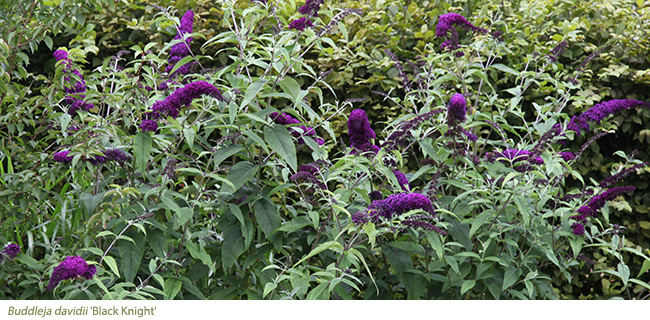
Most flowering plants like a sunny spot, and there are many to choose from, but there are some that need less tender loving care than others. Buddleja are one of these. No they aren't completely maintenance free, but then no plant is! Ideally it should be deadheaded as the flowers fade to encourage more flower and to stop any seedlings, and it will need cutting back in March or April by two-thirds to keep it more compact, but that is all and in return this plant will attract droves of butterflies in July, August and September, which is what we all want in our gardens. Good, award winning forms of Buddleja davidii include ‘Pink Delight’, and the old favourites ‘Black Knight’ and ‘Royal Red’. These make large shrubs (3m x 5m) and they will flower for weeks. A smaller alternative called ‘Lochinch’ (2.5m x 3m) needs lighter pruning and it’s far more delicate in form, with fragrant, lavender-purple flowers each with an orange eye. The foliage is smaller too and much of it stays on in winter.
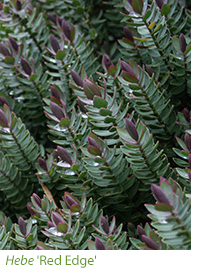 Good front of the border, sun-loving candidates are hebes and these have attractive evergreen foliage that shines in winter. They are bred from New Zealand species so need a warm position and good light to thrive. ‘Heartbreaker’, a new hebe with variegated green and cream narrow leaves, has pink growth so it’s very colourful. ‘Red Edge’, a neat and crisp hebe, has glaucous leaves with red edges and tips. Both will make a dome about 60cm in height. These are deliberately bred for foliage, and if you like the box ball effect, H. rakaiensis forms a tight rounded evergreen shrub with light green foliage.
Good front of the border, sun-loving candidates are hebes and these have attractive evergreen foliage that shines in winter. They are bred from New Zealand species so need a warm position and good light to thrive. ‘Heartbreaker’, a new hebe with variegated green and cream narrow leaves, has pink growth so it’s very colourful. ‘Red Edge’, a neat and crisp hebe, has glaucous leaves with red edges and tips. Both will make a dome about 60cm in height. These are deliberately bred for foliage, and if you like the box ball effect, H. rakaiensis forms a tight rounded evergreen shrub with light green foliage.
Others hebes produce lots of flower throughout summer and the variegated cream and white ‘Silver Queen’ has large purple flowers. Given time, it will make a largish, rounded bush about one metre in height. ‘Pascal’ is half the size, with lavender flowers and grey foliage that turns to burnished burgundy in winter. ‘Garden Beauty’ is a similar height, but the green foliage is topped by masses of purple flowers and it’s said to be hardier than many.
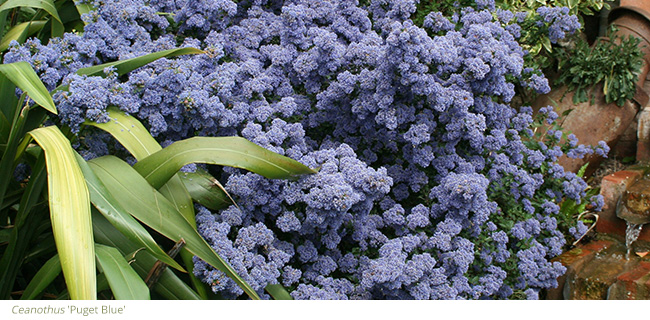
If you’ve got more space and a sheltered spot in sun, away from winds, Californian lilac or ceanothus, will flourish for you. The dark, crinkled, evergreen foliage looks good in winter and in summer deep blue flowers appear. ‘Puget Blue’ gets so smothered in flower that it’s impossible to see the leaves sometimes. It will reach 3m in height. ‘Skylark’ is half the height and equally good.
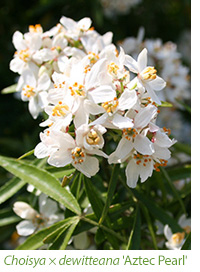 Choisyas are also sun-tolerant and ‘Aztec Pearl’ will provide you with divided foliage and fragrant orange-blossom flowers in late spring. There’s now a pink-flowered form, ‘Apple Blossom’, with pink and white flowers and this reaches just over a metre in height. Choisyas need good light to flower well, but can be grown in partial shade for their foliage. ‘Sundance’ is a yellow-leaved form that you’ll either love or hate.
Choisyas are also sun-tolerant and ‘Aztec Pearl’ will provide you with divided foliage and fragrant orange-blossom flowers in late spring. There’s now a pink-flowered form, ‘Apple Blossom’, with pink and white flowers and this reaches just over a metre in height. Choisyas need good light to flower well, but can be grown in partial shade for their foliage. ‘Sundance’ is a yellow-leaved form that you’ll either love or hate.
You could also use low growing Mediterranean subshrubs such as Artemesia ‘Powis Castle’, lavenders, perovskias and culinary sages. The purple-leafed form, Salvia officinalis ‘Purpurascens’ and the dark-leaved Sedum ‘Purple Emperor’ would add smoky highlights among the silvers and these could be punctuated by Geum ‘Totally Tangerine’. This flowers from May until late, sending up wiry wands of apricot flowers.
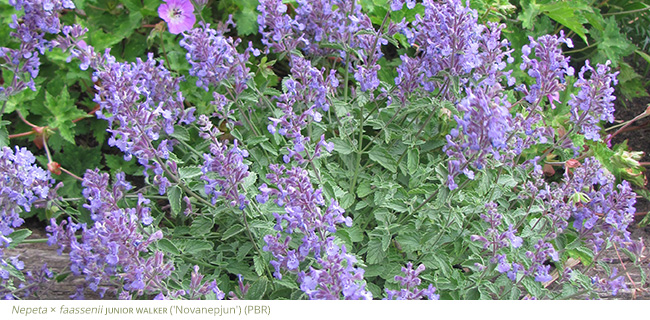
 Weed-smothering silvery perennials include nepetas and ‘Six Hill’s Giant’ will cover a square yard of ground once the stems flop. The much smaller Nepeta × faassenii ‘Junior Walker’ is better where space is limited. Cut ‘Six Hills’ back to nothing in July and it will do it all again, so it’s a very useful plant. Stachys byzantina 'Silver Carpet’ forms a dense mat of foliage and should not flower, or there’s the larger-leaved ‘Big Ears’. Lamium maculatum 'Beacon Silver' will take full sun, but looks best in partial sun because the leaves stay fresher. And this is a good bee plant.
Weed-smothering silvery perennials include nepetas and ‘Six Hill’s Giant’ will cover a square yard of ground once the stems flop. The much smaller Nepeta × faassenii ‘Junior Walker’ is better where space is limited. Cut ‘Six Hills’ back to nothing in July and it will do it all again, so it’s a very useful plant. Stachys byzantina 'Silver Carpet’ forms a dense mat of foliage and should not flower, or there’s the larger-leaved ‘Big Ears’. Lamium maculatum 'Beacon Silver' will take full sun, but looks best in partial sun because the leaves stay fresher. And this is a good bee plant.
Ground cover hardy geraniums for full sun include Geranium ‘Rozanne’, a mid-blue that makes late summer and autumn very special. ‘Dreamland’ is a new lavender-pink that also sprawls. Both are sterile so there are no seedlings, just lots of flowers. ‘Light Dilys’ a clear pink, will do the same job but cover less ground.










